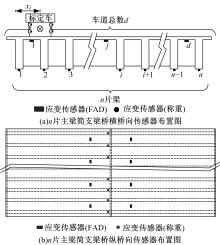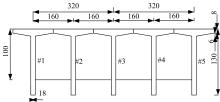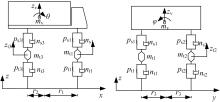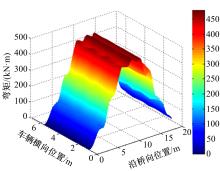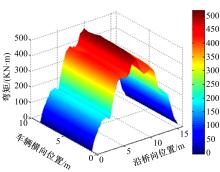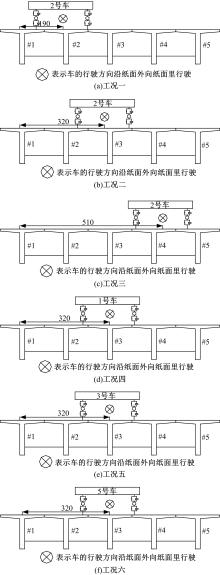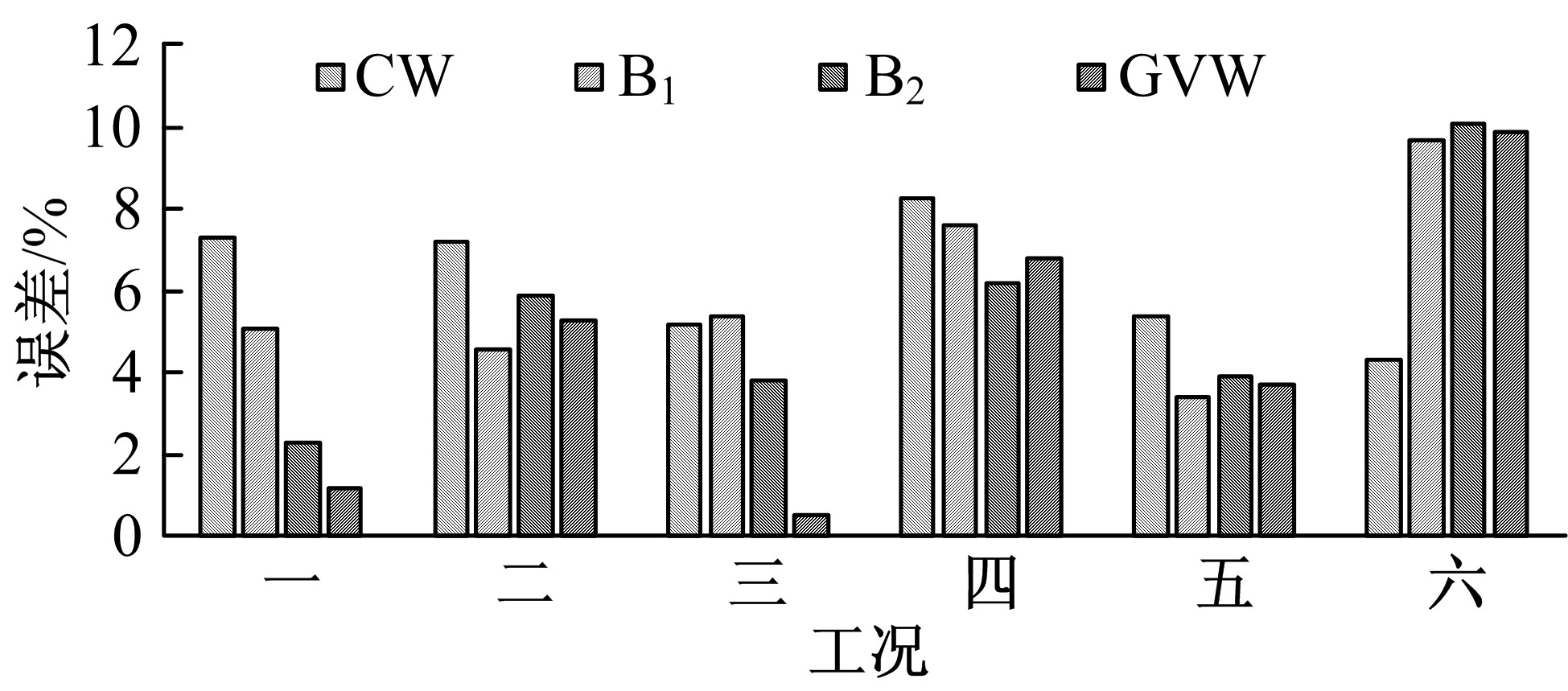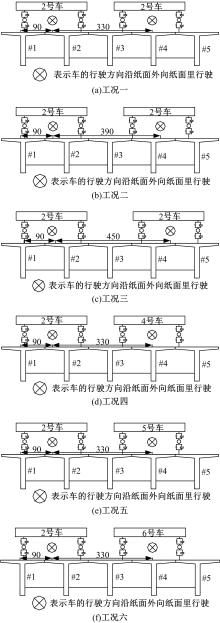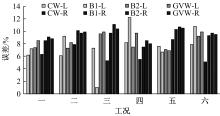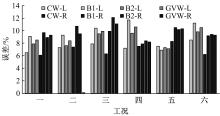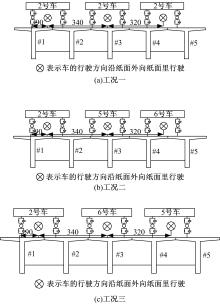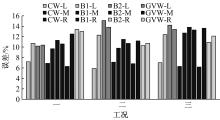Journal of Jilin University(Engineering and Technology Edition) ›› 2021, Vol. 51 ›› Issue (2): 583-596.doi: 10.13229/j.cnki.jdxbgxb20200018
Multi⁃vehicle bridge weigh⁃in⁃motion algorithm
Ya-feng GONG1( ),Jia-xiang SONG1,Guo-jin TAN1(
),Jia-xiang SONG1,Guo-jin TAN1( ),Hai-peng BI1,Yang LIU2,3,4,Cheng-xin SHAN5
),Hai-peng BI1,Yang LIU2,3,4,Cheng-xin SHAN5
- 1.College of Transportation,Jilin University,Changchun 130022,China
2.China Communications Second Navigation Engineering Bureau Co. ,Ltd. ,Wuhan 430040,China
3.Changda Bridge Construction Technology Transportation Industry Key Laboratory,Wuhan 431400,China
4.Transportation Infrastructure Intelligent Manufacturing R&D Center for Transportation Infrastructure,Wuhan 431400,China
5.Changchun Airport Xiangyue Investment Co. ,Ltd. ,Changchun 130000,China
CLC Number:
- U446.2
| 1 | Moses F. Weigh-in-motion system using instrumented Bridges[J]. Transportation Engineering Journal, 1979, 105(3): 233-249. |
| 2 | Peters R J. Axway―a system to obtain vehicle axle weights[J]. Australia Road Research, 1984, 12(2): 17-29. |
| 3 | Peters R J. An unmanned and undetectable highway speed vehicle weighing system[J]. Australian Road Research Board Proceedings, 1986, 1(1): 70-83. |
| 4 | Commission European. Weight-in-motion of axles and vehicles for Europe (WAVE): general report[R]. Paris: LCPC, 2001. |
| 5 | Commission European. Weight-in-motion of axles and vehicles for Europe (WAVE): report of work package 1.2-Bridge WIM systems (B-WIM)[R]. Dublin: University College Dublin, 2001. |
| 6 | Jacob B, O'Brien E J. Weigh-in-motion: recent developments in Europe[C]∥4th International Conference on Weigh-In-Motion, Taipei, 2005: 90-94. |
| 7 | Rowley C W, Gonz A A, O'Brien E J, et a1. Comparison of conventional and regularized bridge weigh-in-motion algorithms[C]∥5th International Conference on Weigh-in-Motion, Paris, 2008: 12-13. |
| 8 | 王林军. 正则化方法及其在动态载荷识别中的应用[D]. 长沙: 湖南大学机械与载运工程学院, 2011. |
| Wang Lin-jun. Regularization method and its application in dynamic load identification[D]. Changsha: School of Mechanical and Transportation Engineering, Hunan University, 2011. | |
| 9 | 龙波. 移动车辆轴重识别MOSES算法在宽桥中的应用研究[D]. 长沙: 湖南大学土木工程学院, 2014. |
| Long Bo. Application of MOSES algorithm for axle weight identification of moving vehicles in wide bridges[D]. Changsha: School of Civil Engineering, Hunan University, 2014. | |
| 10 | 邓露, 施海, 何维, 等. 基于虚拟简支梁法的桥梁动态称重研究[J]. 振动与冲击, 2018, 37(15): 209-215. |
| Deng Lu, Shi Hai, He Wei, et al. Research on dynamic weighing of bridges based on virtual simply supported beam method[J]. Vibration and Shock, 2018, 37(15): 209-215. | |
| 11 | Zolghadri N, Halling M W, Johnson N, et al. Field verification of simplified bridge weigh-in-motion techniques[J]. Journal of Bridge Engineering, 2016, 21(10): 4016063. |
| 12 | Quilligan M. Bridge weigh-in-motion: development of a 2-D multi-vehicle algorithm[J]. Trita-BKN Bulletin, 2003, 1(1): 23-35. |
| 13 | 刘洋. 基于Moses算法的单车及多车动态称重算法研究[D]. 长春: 吉林大学交通学院, 2019. |
| Liu Yang. Study on the BWIM algorithm of a vehicle or multi-vehicles based on the Moses algorithm[D]. Changchun: College of Transportation, Jilin University, 2019. | |
| 14 | Zhao H, Uddin N, O'Brien E J, et al. Identification of vehicular axle weights with a bridge weigh-in-motion system considering transverse distribution of wheel loads[J]. Journal of Bridge Engineering, 2013, 19(3): 04013008. |
| 15 | Tikhonov A N, Arsenin V Y. Solutions of ill-posed problems[J]. Mathematics of Computation, 1977, 32(144): 1-258. |
| 16 | 汤海燕, 蔡晶. 桥梁结构影响面与影响线的比较研究[C]∥江苏省力学学会青年力学论坛, 南京, 2005: 104-108. |
| 17 | 李希. 点云数据处理及规则曲面拟合[D]. 太原: 中北大学计算机科学与技术学院, 2017. |
| Li Xi. Point cloud data processing and regular surface fitting[D]. Taiyuan: College of Computer Science and Technology, North University of China, 2017. | |
| 18 | 刘福寿. 基于车桥耦合振动的混凝土简支梁桥动力特性研究[D]. 长春: 吉林大学交通学院, 2009. |
| Liu Fu-shou. Study on the dynamic characteristics of a simply supported concrete beam bridge based on vehicle-bridge coupling vibration[D]. Changchun: College of Transportation, Jilin University, 2009. | |
| 19 | Huang D, Wang T L. Impact analysis of cable-stayed bridge[J].Computers and Structures, 1992, 43(5): 897-908. |
| 20 | 谭国金, 刘子煜, 魏海斌, 等. 偏心直线预应力筋简支梁自振频率计算方法[J]. 吉林大学学报: 工学版, 2016, 46(3): 798-803. |
| Tan Guo-jin, Liu Zi-yu, Wei Hai-bin, et al. Calculation method of natural vibration frequency of simply supported beam with eccentric linear prestressed tendons[J]. Journal of Jilin University (Engineering and Technology Edition), 2016, 46(3): 798-803. | |
| 21 | 宫亚峰, 何钰龙, 谭国金, 等. 三跨独柱连续曲线梁桥抗倾覆稳定性分析[J]. 吉林大学学报: 工学版, 2018, 48(1): 113-120. |
| Gong Ya-feng, He Yu-long, Tan Guo-jin, et al. Three-span single-column continuous curve beam bridge anti-overturning stability analysis[J]. Journal of Jilin University (Engineering and Technology Edition), 2018, 48(1): 113-120. |
| [1] | Qing-wen KONG,Guo-jin TAN,Long-lin WANG,Yong WANG,Zhi-gang WEI,Han-bing LIU. Analysis of free vibration characteristics of cracked box girder bridge based on finite element method [J]. Journal of Jilin University(Engineering and Technology Edition), 2021, 51(1): 225-232. |
| [2] | Hua CHEN,Yao-jia CHEN,Bin XIE,Peng-kai WANG,Lang-ni DENG. Interface failure mechanism and bonding strength calculation of CFRP tendons bonded anchorage system [J]. Journal of Jilin University(Engineering and Technology Edition), 2020, 50(5): 1698-1708. |
| [3] | Ya-feng GONG,Jia-xiang SONG,Hai-peng BI,Guo-jin TAN,Guo-hai HU,Si-yuan LIN. Static test and finite element analysis of scale model of fabricated box culvert [J]. Journal of Jilin University(Engineering and Technology Edition), 2020, 50(5): 1728-1738. |
| [4] | Hao GAO,Jun-jie WANG,Hui-jie LIU,Jian-ming WANG. Design criterion and applied devices for controlled seismic behavior of continuous girder bridges [J]. Journal of Jilin University(Engineering and Technology Edition), 2020, 50(5): 1718-1727. |
| [5] | Qian-hui PU,Jing-wen LIU,Gang-yun ZHAO,Meng YAN,Xiao-bin LI. Theoretical analysis of bearing capacity of concrete eccentric compressive column reinforced by HTRCS [J]. Journal of Jilin University(Engineering and Technology Edition), 2020, 50(2): 606-612. |
| [6] | Yun-long ZHANG,Yang-yang GUO,Jing WANG,Dong LIANG. Natural frequency and mode of vibration of steel⁃concrete composite beam [J]. Journal of Jilin University(Engineering and Technology Edition), 2020, 50(2): 581-588. |
| [7] | Bo-xin WANG,Hai-tao YANG,Qing WANG,Xin GAO,Xiao-xu CHEN. Bridge vibration signal optimization filtering method based on improved CEEMD⁃multi⁃scale permutation entropy analysis [J]. Journal of Jilin University(Engineering and Technology Edition), 2020, 50(1): 216-226. |
| [8] | Miao ZHANG,Yong-jiu QIAN,Fang ZHANG,Shou-qin ZHU. Experimental analysis of spatial force performance of concrete-reinforced stone arch bridge based on enlarged section method [J]. Journal of Jilin University(Engineering and Technology Edition), 2020, 50(1): 210-215. |
| [9] | Yi JIA,Ren-da ZHAO,Yong-bao WANG,Fu-hai LI. Sensitivity analysis of viscous damper parameters for multi⁃span and long⁃unit continuous girder bridges [J]. Journal of Jilin University(Engineering and Technology Edition), 2019, 49(6): 1871-1883. |
| [10] | Chun-ling ZHONG,Dong LIANG,Yun-long ZHANG,Jing WANG. Calculation of natural vibration frequency of simply supported beam strengthened by external prestressing [J]. Journal of Jilin University(Engineering and Technology Edition), 2019, 49(6): 1884-1890. |
| [11] | Lun-hua BAI,Rui-li SHEN,Xing-biao ZHANG,Lu WANG. In-plane stability of self-anchored suspension bridge [J]. Journal of Jilin University(Engineering and Technology Edition), 2019, 49(5): 1500-1508. |
| [12] | Jin⁃gang ZHAO,Ming ZHANG,Yu⁃lin ZHAN,Ming⁃zhi XIE. Damage criterion of reinforced concrete pier based on plastic strain energy density [J]. Journal of Jilin University(Engineering and Technology Edition), 2019, 49(4): 1124-1133. |
| [13] | Shi⁃cheng WAN,Qiao HUANG,Jian GUAN,Zhao⁃yuan GUO. Strengthening of continuous steel⁃concrete composite beams in negative moment region using prestressed carbon fiber⁃reinforced polymer plates [J]. Journal of Jilin University(Engineering and Technology Edition), 2019, 49(4): 1114-1123. |
| [14] | Wan⁃heng LI,Lin SHEN,Shao⁃peng WANG,Shang⁃chuan ZHAO. Damage assessment of bridge construction based onmulti⁃stage subregion mobile test [J]. Journal of Jilin University(Engineering and Technology Edition), 2019, 49(3): 773-780. |
| [15] | HUI Ying-xin,MAO Ming-jie,LIU Hai-feng,ZHANG Shang-rong. Influence of structural seismic response of bridges crossing active fault [J]. Journal of Jilin University(Engineering and Technology Edition), 2018, 48(6): 1725-1734. |
|
||
